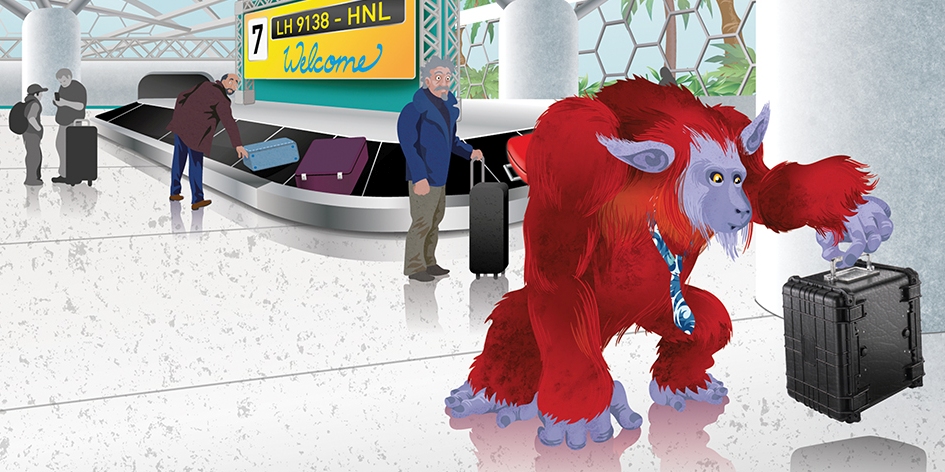How film teams can work productively even without a (mobile) network connection
Exterior shots for films, documentaries or for onsite live reporting require a good signal. Today, video data is usually transmitted directly to post production via bundled 5G connections for further processing. But what does the film crew do if they have no or only a poor network signal at the filming location?
In this case, the camera team needs a mobile storage solution that allows the video data to be safely transported to the next large town with a good signal, or to the next transmitter station or to the production company. The data storage must therefore be portable, robust and very well secured.
Comprehensive protection is vital – here’s why
The device must be robust enough to withstand shocks and vibrations as well as water and extreme temperatures to protect the stored data. Because no signal usually means that the team filming in a remote location in the mountains, in a desert, at sea, maybe even somewhere in Alaska or in a war zone.
However, it is not enough if only the case is robust – the hard drives as well as the built-in electronics must also be well attached and cushioned inside. If the storage unit is to be flown out, the box also needs an air bleed bolt to prevent condensation inside from damaging the electronics.
Which security aspects you should consider for sensitive video data
No need to say that the sensitive film material should not fall into the wrong hands before the premiere or first broadcast and must definitely arrive safely at the post-production stage. For this reason, highly sensitive raw data, such as film material for a future blockbuster, is sent in parallel with at least two trusted couriers. They’re usually travelling on different routes with different transportation vehicles and they will never be on the same flight. Like the transport of money or valuables, couriers and mobile data safes are securely connected to each other by handcuffs.
The basic requirement is that the stored data is encrypted and only authorised persons can access the data when they’re properly authenticated.
Have your own box
Some cloud providers offer secure data transfers as a service but most of the time the data can only be uploaded into one of the big international public clouds. On one hand this increases the risk of being unable to comply with strict data security regulations. On the other hand, it implies a vendor lock-in because there’s no choice; the data can be transferred to provider’s cloud only. In addition, the storage box remains the provider’s property and can only be rented.
Although the cloud providers promise that the client data is always securely and completely deleted when the job is done and the box returned, this is difficult to verify. With your own mobile storage system, all data remains in your own hands at all times and thus under control; as long as the box itself is not falling into the wrong hands or is handed over to a third party.
How should a mobile data safe look like?
Such a storage system must be an armoured data safe. Our Hibagon® – Mobile Data Safe , for example, complies with IP45 and is suitable for temperatures of +5°C to +40 °C when the data is read or written. In non-operational mode, i.e. during transport, temperatures can range from -40°C to +65 °C. This means that the data can also be transported through rugged environments. In addition, the mobile data safe has an air bleed bolt, can be locked and handcuffs attached to the robust handle can connect to the courier’s wrist or the transportation vehicle, if required.
The integrated storage solution contains up to 8 enterprise class HDDs with useable capacities from 28 TB up to 140 TB
The OpenZFS file system supports multiple storage protocols, including NFS, which is widely used in the media and entertainment industry. In addition, the data can be stored via SMB, AFP, object-based via S3 or block-based via iSCSI and FTP data transfer is also supported. Hibagon® is a RAID 5 storage system and supports various security protocols such as AD, LDAP, SSH and AES-XTS for secure access to the data. Two 10 Gigabit/s SFP ports and 1/10 Gigabit Ethernet RJ45 ports are available as network interfaces and there are also monitoring and USB ports.
The Hibagon® Mobile Data Safe product family starts with this NAS storage solution (NAS: Network Attached Storage) and will grow next year. We will be adding a smaller, slightly lighter model with reduced storage capacity and additional ports tailored to the needs of film production. In this box for example, the film team can insert the camera’s memory cards into an SD slot and import the data directly.
What else can you do with your mobile data safe?
This Hibagon® Mobile Data Safe will therefore ideal for the exterior shots without a (quality) signal as described at the beginning of this article. Couriers can transport the film data securely from the middle of nowhere to the next location with a good signal and then use powerful interfaces to upload the data into the network for further processing by post production teams. Highly sensitive video data can be securely transported straight to the production company just like transporting money or valuables.
The NAS version of Hibagon® Mobile Data Safe is already available, enables post-production teams to store sensitive video or film data offline and transport them securely to the location they’re needed. Hibagon® can also be used as a back-up and recovery solution allowing quick access to data even when a disaster like a ransomware attack strikes.
For further information please visit: https://hibagon.de
Please contact us in case of any questions: channel@rnt.de



